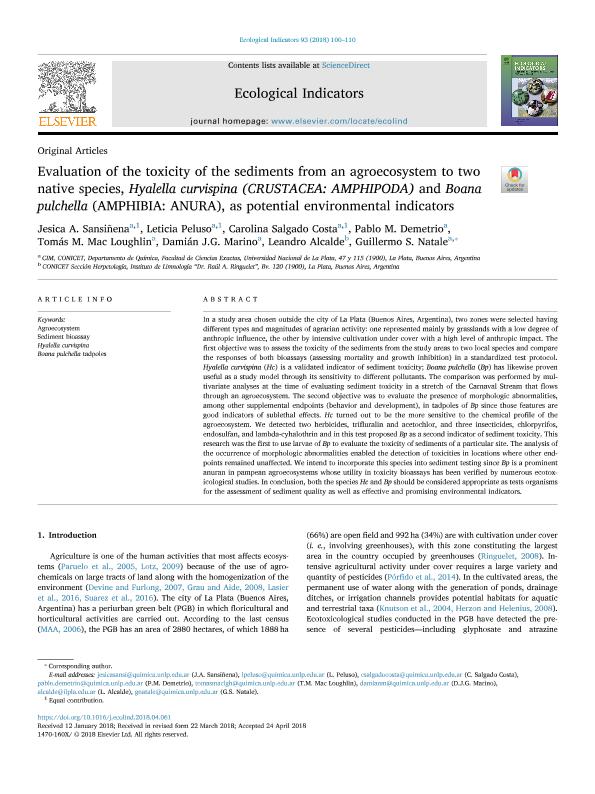Artículo
Evaluation of the toxicity of the sediments from an agroecosystem to two native species, Hyalella curvispina (CRUSTACEA: AMPHIPODA) and Boana pulchella (AMPHIBIA: ANURA), as potential environmental indicators
Sansiñena, Jesica Alejandra ; Peluso, María Leticia
; Peluso, María Leticia ; Salgado Costa, Carolina
; Salgado Costa, Carolina ; Demetrio, Pablo Martin
; Demetrio, Pablo Martin ; Mac Loughlin, Tomas Mariano
; Mac Loughlin, Tomas Mariano ; Marino, Damian Jose Gabriel
; Marino, Damian Jose Gabriel ; Alcalde, Leandro
; Alcalde, Leandro ; Natale, Guillermo Sebastian
; Natale, Guillermo Sebastian
 ; Peluso, María Leticia
; Peluso, María Leticia ; Salgado Costa, Carolina
; Salgado Costa, Carolina ; Demetrio, Pablo Martin
; Demetrio, Pablo Martin ; Mac Loughlin, Tomas Mariano
; Mac Loughlin, Tomas Mariano ; Marino, Damian Jose Gabriel
; Marino, Damian Jose Gabriel ; Alcalde, Leandro
; Alcalde, Leandro ; Natale, Guillermo Sebastian
; Natale, Guillermo Sebastian
Fecha de publicación:
10/2018
Editorial:
Elsevier Science
Revista:
Ecological Indicators
ISSN:
1470-160X
Idioma:
Inglés
Tipo de recurso:
Artículo publicado
Clasificación temática:
Resumen
In a study area chosen outside the city of La Plata (Buenos Aires, Argentina), two zones were selected having different types and magnitudes of agrarian activity: one represented mainly by grasslands with a low degree of anthropic influence, the other by intensive cultivation under cover with a high level of anthropic impact. The first objective was to assess the toxicity of the sediments from the study areas to two local species and compare the responses of both bioassays (assessing mortality and growth inhibition) in a standardized test protocol. Hyalella curvispina (Hc) is a validated indicator of sediment toxicity; Boana pulchella (Bp) has likewise proven useful as a study model through its sensitivity to different pollutants. The comparison was performed by multivariate analyses at the time of evaluating sediment toxicity in a stretch of the Carnaval Stream that flows through an agroecosystem. The second objective was to evaluate the presence of morphologic abnormalities, among other supplemental endpoints (behavior and development), in tadpoles of Bp since those features are good indicators of sublethal effects. Hc turned out to be the more sensitive to the chemical profile of the agroecosystem. We detected two herbicides, trifluralin and acetochlor, and three insecticides, chlorpyrifos, endosulfan, and lambda-cyhalothrin and in this test proposed Bp as a second indicator of sediment toxicity. This research was the first to use larvae of Bp to evaluate the toxicity of sediments of a particular site. The analysis of the occurrence of morphologic abnormalities enabled the detection of toxicities in locations where other endpoints remained unaffected. We intend to incorporate this species into sediment testing since Bp is a prominent anuran in pampean agroecosystems whose utility in toxicity bioassays has been verified by numerous ecotoxicological studies. In conclusion, both the species Hc and Bp should be considered appropriate as tests organisms for the assessment of sediment quality as well as effective and promising environmental indicators.
Archivos asociados
Licencia
Identificadores
Colecciones
Articulos(CCT - LA PLATA)
Articulos de CTRO.CIENTIFICO TECNOL.CONICET - LA PLATA
Articulos de CTRO.CIENTIFICO TECNOL.CONICET - LA PLATA
Articulos(ILPLA)
Articulos de INST.DE LIMNOLOGIA "DR. RAUL A. RINGUELET"
Articulos de INST.DE LIMNOLOGIA "DR. RAUL A. RINGUELET"
Citación
Sansiñena, Jesica Alejandra; Peluso, María Leticia; Salgado Costa, Carolina; Demetrio, Pablo Martin; Mac Loughlin, Tomas Mariano; et al.; Evaluation of the toxicity of the sediments from an agroecosystem to two native species, Hyalella curvispina (CRUSTACEA: AMPHIPODA) and Boana pulchella (AMPHIBIA: ANURA), as potential environmental indicators; Elsevier Science; Ecological Indicators; 93; 10-2018; 100-110
Compartir
Altmétricas



